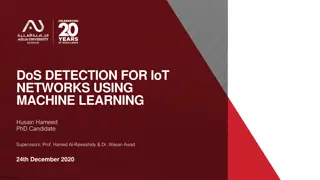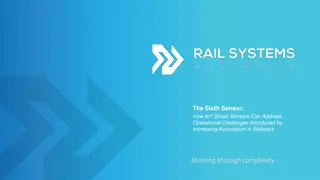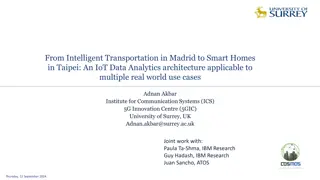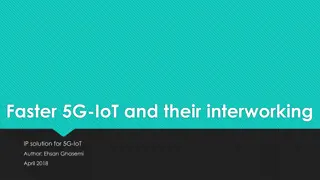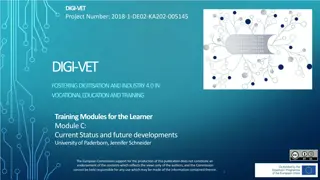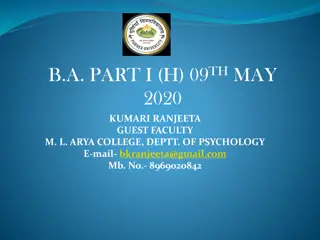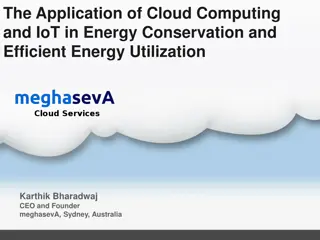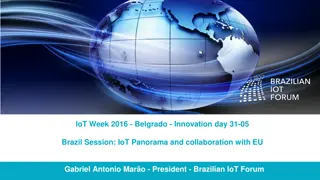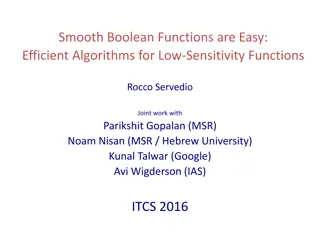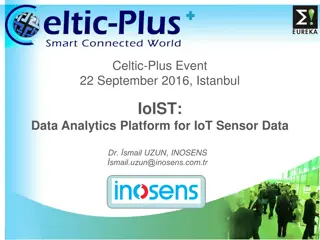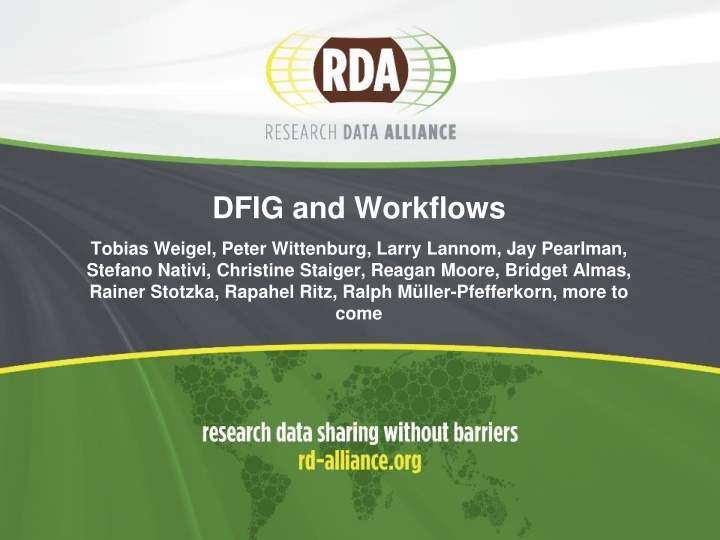
Data Fabrics and IoT Challenges: Coping with Complexity
In the realm of data fabrics and Internet of Things (IoT), addressing the escalating volume and intricacy of data poses a significant challenge. The integration of data from diverse sources is costly, leading to data inaccessibility and wasted time for data scientists. As the number of smart devices increases, managing the data influx becomes more daunting, while the complexity of data systems continues to grow. Fundamental shifts in data processing and human interactions are necessary to navigate this evolving landscape.
Download Presentation

Please find below an Image/Link to download the presentation.
The content on the website is provided AS IS for your information and personal use only. It may not be sold, licensed, or shared on other websites without obtaining consent from the author. If you encounter any issues during the download, it is possible that the publisher has removed the file from their server.
You are allowed to download the files provided on this website for personal or commercial use, subject to the condition that they are used lawfully. All files are the property of their respective owners.
The content on the website is provided AS IS for your information and personal use only. It may not be sold, licensed, or shared on other websites without obtaining consent from the author.
E N D
Presentation Transcript
DFIG and Workflows Tobias Weigel, Peter Wittenburg, Larry Lannom, Jay Pearlman, Stefano Nativi, Christine Staiger, Reagan Moore, Bridget Almas, Rainer Stotzka, Rapahel Ritz, Ralph M ller-Pfefferkorn, more to come
Work Flow in Data Fabrics 2 General aspects Human and type controlled processing DFIG basics: still fitting? Required components RDA groups contributing
The Great Challenge 3 How to cope with the increasing volume and complexity of scientific and industrial data Currently integration of data from different sources is expensive 80% of the data is no longer accessible after a short time 80% of time of data scientists is wasted with data management And it will get worse 50 Bio Smart devices will create data monsters (continuous feed, fine granularity)
Expected Developments 4 50000 45000 40000 35000 30000 devices (Mio, Intel) 25000 data (EB, Oracle) 20000 15000 10000 5000 0 2000 2005 2010 2015 2020 And, simultaneously, complexity will increase!!!
Fundamental Changes due to IoT 5 Humans Cyber infrastructure Physical Objects adapted from Chris Greer, NIST
Fundamental Changes due to IoT 6 Humans Actors Mediators Internet WWW etc. Physical Objects adapted from Chris Greer, NIST
Fundamental Changes due to IoT 7 Humans often bypassed Cyber infrastructure PO directly acting adapted from Chris Greer, NIST Cyber
Brokering & Complexity 8 Object implemen tation Conceptual Object Object implemen tation Object implemen tation Allow different implementations of a common conceptual object Artifact Type A Type B Artifact Artifact Mediate among different artifact types Artifact
Workflow Abstractions and Implementations 9 Distinguish between two different types of Workflow specifications/notations Abstract Workflow Executable Workflow Abstract Workflow (Business Process) specification Generated by Process Experts Based on abstract and well known object types Implementation/Technology independent Executable Workflow Generated by IT experts e.g. Web Services experts Based on accessible object implementations e.g. Web Services Technology dependent e.g. workflow engines and related languages
Workflow Abstractions and Implementations 10 GAP Executable Workflow(s) Abstract Business Process PID and Object typing help fill the gap Brokering services (e.g. Data services brokering, Processing services brokering) help fill the gap.
Content 11 general aspects General aspects Human and type controlled processing human and type controlled processing DFIG basics: still fitting? DFIG basics still fitting? Required components RDA groups contributing
Human Controlled Processing (HCP) 12 Observations Experiments Simulations etc. Cycle can be manually controlled or semi-automatically via pre-set pipelines. Even in case of semi-automatic pipelines humans are close-in "designers (diagram is well-known in DFIG)
Type-Triggered Automatic Processing (T-TAP) 13 New feature: cycles run highly autonomously - precise steps depend on the types of data entering the workflow Data Events exposing new DOs Structured Data Markets adding new data some kind of profile matching Researchers are not in direct control Data Type Registry Data Federation Agents Processing services result Brokering & Mediation services scripts
Use Case #1 14 A neurologist wants to research the causal relation between Alzheimer phenomena and specific genes, proteins, neural activity, etc. She needs as much data as possible from patients exposing the same phenomena. Such data is being generated in a variety of hospitals and labs worldwide by different experts. As this is sensitive data, she works in a federation based on strict usage agreements using certified software. She engages a federation agent which is provided with profiles of data she can use for her research, specifying the disease and the data types she can use. Whenever useful data is generated her machine learning based algorithms will run to provide new evidence to improve her theories.
Use Case #2 15 A linguist is working on theories about economy of languages , i.e., finding objective patterns that make languages more or less easy to process and learn. He needs detailed feature descriptions at different linguistic levels from a wide spectrum of languages which are generated in many labs worldwide by different experts. Since this data is in general open there is no need of a specific federation. He engages an agent which is provided with profiles of data he can use for his research, specifying the languages, features, and approach to extracting the features. Whenever useful data is generated machine learning based algorithms are run to provide evidence to improve his research.
Use Case #3 16 The data manager of a large data centre has the obligation to check the quality of new data of specific types, transform it according to certain rules/policies and create n replications in a federation. He decides to work asynchronously and use agents to scan the offers of a variety of repositories in his user federation for new data of the specified types. The agent scans the offers from the repositories and whenever new data of the specified profiles is found, quality checks are carried out transformations are applied and replicants are generated in the centre s federation.
Principle Differences 17 HCP procedural T-TAP declarative profile driven asynchronous brokered third party services, it becomes a business Human role Aggregation designed Events planned Mapping designed flexible in case of human control detailed in case of WF Required Metadata detailed Typing (semantics) PID types DFT model optional required optional optional required required
Core "reproducibility machine in both cases 18 Brokering & Mediation services add-on new DO(s) source DO(s) Bit Sequence Bit Sequence shown is a suggestion for systematic documentation (several implementations possible) assumed is that DOs in a collection will be processed to create new DOs incl. new content, new PIDs and MD extended by new provenance information interaction pattern see next slide
interaction pattern 19 1. read new PID from collection DO 2. get PID record 3. get metadata (incl. provenance) 4. get bitstream from trustworthy repository 5. do the processing on the bit sequence a. run brokering & mediation services where useful 6. create new bit sequence 7. register new PID 8. create new metadata (incl. updated provenance) 9. upload data and metadata to a trustworthy repository 10. back to 1 if more DOs available in collection the green marked items can be ready made code snippets!
What is structured Data Market? 20 Repository x Repository y repositories expose PIDs representing new DOs ResourceSync W3C Standard PIDs Profiles Federation Agreements Agent j Agent k not all agents can see all exposed PIDs at this stage bit sequences are not touched (GDOC)
How to relax a Federation agreement 21 Repository x Repository y Agents can make use of Brokering services to avoid repositories to implement the same metadata model/structure Brokering & Mediation services Agent j
What is the market? (I) 22 Market: Stalls (providers) with offers and customers with needs Market is a social space that facilitates matchmaking between these Brokers may also be involved in case the customers delegate the matchmaking Offers = PIDs (with their embedded/referenced metadata and pointers to the bit sequences) Required to maintain the market: registry of providers Requirement: In e.g. medicine, not all offers (PIDs) should be visible Even the existence of a PID may be sensitive information therefore federation agreements need to be established where necessary
What is the market? (II) 23 Now we can imagine different models: A: Open data provider/customer market All providers are visible, but not everyone is allowed to look into all stalls; meaning: even the medicine service endpoints are listed, but access requires specific permissions. Federation agreements are then simply the organizational format in which permissions are given to a specific customer group B: Provider group/Customer group federation market Not all providers are visible, so normal users are not even able to see the medicine service endpoints. In this case, a second (higher-level) market for making federation agreements is required. These agreements are between groups of providers and groups of customers. The data market is then not flat and open, but more complex: Every market stall is behind a black curtain, and the doorman in front of the curtain will check credentials to even know what is behind the curtain There can still be stalls without a curtain, following the open market model.
Matching in federation environment 24 Repository metadata of DO bit sequences of DO PID Resolver MD bs 1 PID record DTR 5 PID Rights DB Type Record 3 2 12 4 6 rights record 13 10 Agent 9 Y 8 7 11 Controller WF 14 Matcher 14 14 Broker Profiles Broker Broker
Requirements and observations 25 First repositories are active and signalise new DOs using ResourceSync (W3C) Then agent is the key-active part crawling known offers The agent makes decisions The agent can act upon missing replies (time-out) it controles the flow When agent found a new DO suitable for the intended processing the controller becomes active Interfaces/protocols required for every arrow Some of them are already defined or being addressed in active RDA groups, but some are missing Example for missing piece: Communication between agent and matcher
Procedure 26 1. 2. 3. 4. 5. 6. 7. 8. 9. 10. controller will look into data type registry and get record incl. actions to be carried out on the type 11. controller will start and observe processing (workflow, etc.) 12. bit sequences will be read and processed to new results 13. new PID, data and metadata will be registered at/via repository 14. brokering services will be needed to map between different formats, name spaces, etc. repository will expose PIDs of new data agent will scan known ResouceSync offers and get PIDs agent will ask for PID record agent will get PID record agent will get MD record from repository agent will check whether access rights & licenses are ok agent will hand over info bundle to Profile Matcher Matcher will read his profiles and compare in case of fit agent will give info bundle to controller
Closed Cycle Solutions 27 in simulations data is generated by own software quality control is integrated no need to leave the domain of registered DOs however gate keeper for the software collection building proper repository processing checked code to be added (workflows, scripts, etc.) new collection
About Metadata in WF (pipelines) 28 in Workflows typing by metadata needs to be fine-graded going beyond the usual metadata such as system metadata descriptive metadata PID Metadata bit sequence processing component in general additional information is required for the machines history of software that created the bit sequence versions of the software in case that different types of output can be generated the exact parameter set needs to be documented etc. PID Metadata bit sequence processing component this information is to be included in provenance records as part of the metadata detail metadata to be fit for machine use PID Metadata bit sequence
WFs require PID registration strategies 29 taken from DKRZ/ENES
Future: Data and workflow integration 30 Goal: Make the life easier for scientists who are no experts in programming and handling data Portals: integrate data and compute workflows Data Workflow Result Preview: Set 1 Set 2 Set 3 Data: <PID>
Future: Data and workflow integration 31 Label data with PID Label (parts of) workflows with PIDs #Load data mRNA = W1(D1) miRNA = W1(D2) PID D1 PID D2 PID D3 #Analysis res1 = W2(mRNA, miRNA) res = W3(res1) PID W1 PID W2 PID W3 PID W4 #PID for result file = writeToFile(res) create_PID(file) #Plot for preview Plot(res)
WHY? Data and workflow integration 32 Why this effort? Different stakeholders with different expertise: Scientists are users Scientific programmers: experts on algorithms Data managers: care for data curation How can this work? PID information types: Structured PIDs for different objects: data, workflows Information in PID record helps combining the right objects in the right way PIT model checking with Data Type registry
Controls for Workflows 33 multiple independent services are used to manipulate/manage digital objects, i.e. automated coordination is required between the services to ensure that assertions remain valid how to enforce assertions made about a collection when a service is applied to a digital object. Examples of assertions range from: integrity access control authenticity provenance chain of custody arrangement description
should DO be self-contained? 34 MD MD included problem problem n.a. problem problem less small separate easy easy easy easy easy higher high data protection data volumes database content dynamic metadata citation stability complexity dependency many formats have integrated MD take best of both, i.e. make use of headers, but also extract MD, however, maintenance complexity requires DFT model use
Content 35 general aspects general aspects human and type controlled processing human and type controlled processing DFIG basics still fitting? DFIG basics still fitting? required components RDA groups contributing
principle of configurations remains 36 configuration A configuration B Common Components & Services Specific Components & Services Task to solve: - Identify and specify Common Components (CoCo) - Recommend CoCo - Put CoCo in place Task is not to identify ONE architecture, but to identify CoCos that could cooperate in specific configurations to solve a function (infra, VRE, etc.)
seeing PIDs central remains the same 37 PID Record PID PID CKSM PID PID paths PID Metadata Rights Relations Provenance
PID PID Centric Data Management and Access Centric Data Management and Access Brokering & Mediation services
PID PID Centric Data Management and Access Centric Data Management and Access PID CDMAStorage Systems Users B B Consumer Provider Consumer Provider
Types of Data Fabrics (Reagan) 41 we can differentiate between user data fabrics to support discovery and access to published data collaboration data fabrics that support processing of shared collections repository data fabrics that are focusing on preserving data Supported virtualized entities in these DFs are data collections that include the context of DOs workflows encapsulating analyses data flows managing data transport Essential capabilities are interoperability, federation, interaction control
Nature of Data Fabrics 42 Obviously Data Fabrics in the above sense are blueprints to create generic infrastructures that support virtualisation of collections, workflows and data flows Instantiations of Data Fabrics will offer a set of services some of which are core and others are optional Data Fabrics are NOT instantiations of a specific collection, workflow or data flow.
Content 43 general aspects human and type controlled processing DFIG basics still fitting? required components RDA groups contributing
required core components 44 DO registration a piece of code that allows to register a DO, i.e. store bit sequence in a trustworthy repository, request a PID and register metadata at GDOC level operators such as MOVE, COPY, DELETE need to be provided a piece of code that requests PIDs and initiates the PID record according to a profile a secure program that allows authorised entities to modify the PID record within federations a set of certification rules to assess the quality of PID service providers a piece of code that gets metadata via the PID information type a piece of code that creates new metadata incl. a new provenance record DO management PID initiation remote PID change PID provider certification metadata extractor metadata generator
required components 45 collection builder a software that allows humans and machines to create a collection a registry that allows to associate types with operations a registry which contains license agreements from different users to be used in federation access chains a registry which contains rights records to be used in federations registry of trusted federation centers a registry of core components incl. a quality and security test a registry that contains schema definitions a registry that contains vocabularies and individual categories data type registry license registry rights & license registry repository registry CoCo registry schema registry category registry
required components 46 a W3C standard to expose offers from repositories a standard allowing to write prov records different types of brokers for transformations, mappings, etc. a clarification of suitable and agreed metadata components a registered set of common PID types ResourceSync provenance resource broker common metadata model common PID types
Metadata Structure 47 How can metadata structure be brought in? Metadata Components/Packages as discussed by MD IG Unique Identifier (for later use including citation) Location (URL) Description Keywords (terms) Temporal coordinates Spatial coordinates Originator (organisation(s) / person(s)) Project Facility / equipment Quality Availability (licence, persistence) Provenance Citations Related publications (white or grey) Related software Schema Medium / format
Content 48 general aspects general aspects human and type controlled processing human and type controlled processing DFIG basics still fitting? DFIG basics still fitting? required components RDA groups contributing
RDA groups contributing 49 RDA Group DFT PIT DTR Dyn DC PP MDC DSA/WDS DF Publ Data Services Publ Data Workflows requirements for scientific workflows Reproducibility recommendations to make data reproducible Legal Interop recommendations about data licences providing ... a basic FAIR compliant model to organise data the notion of attribute profiles of PID services a mechanism to link data types with operations a mechanism to correctly refer to data a large number of cases for typical operations a metadata schema registry a set of rules to assess the quality of repositories a framework to discuss this document a mechanism to universally link data and literature
RDA groups contributing 50 Brokering Framework Collection studying the possibilities to apply brokering Provides collection builder interface specifications

